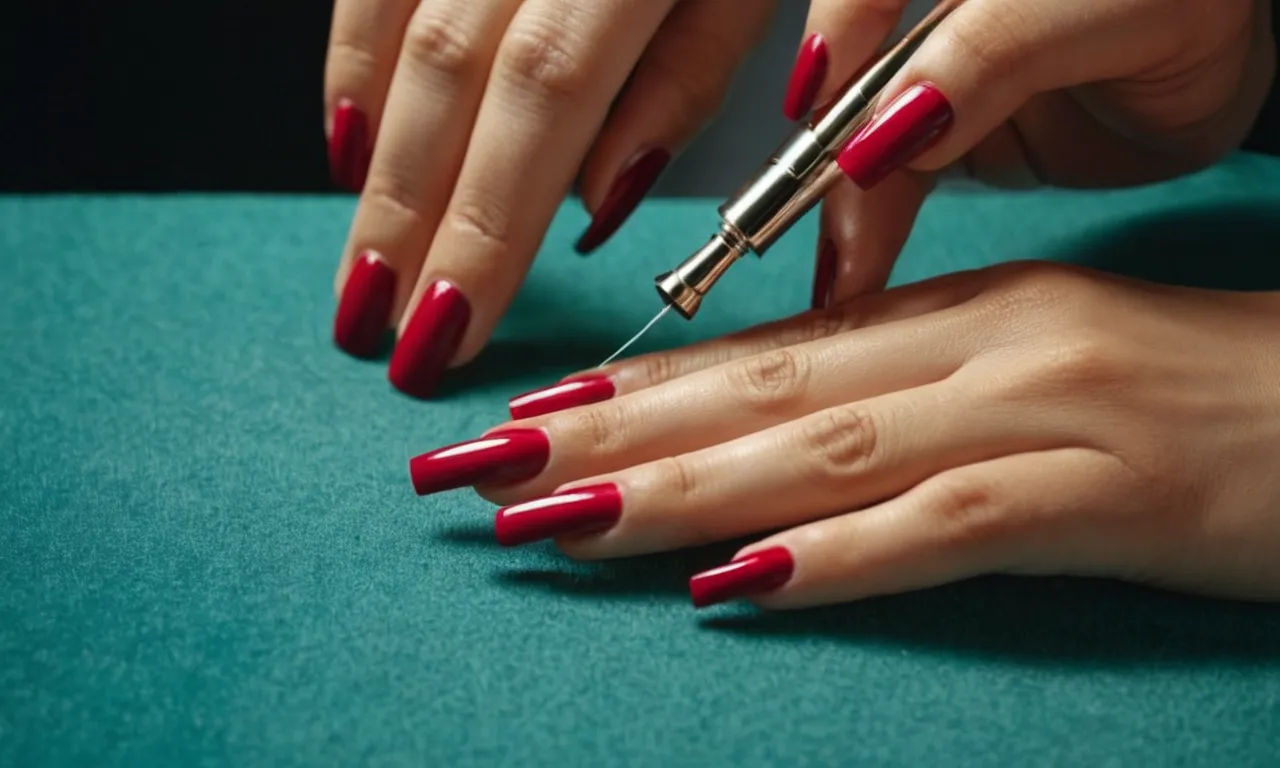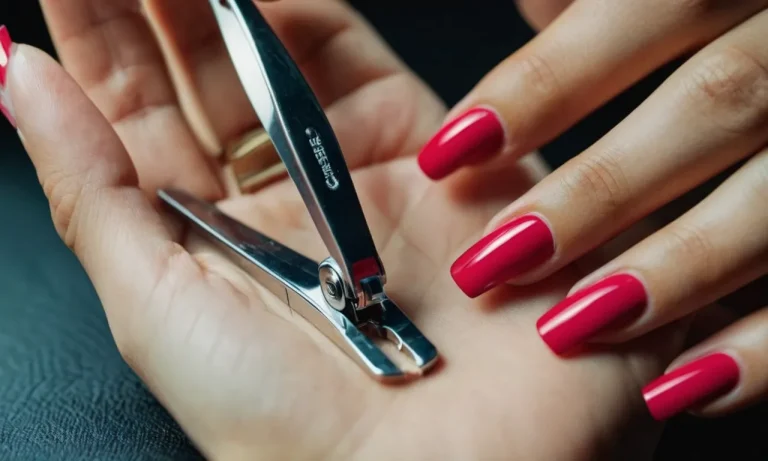How To Get A Nail Tech License: The Complete Guide
Getting a license to become a professional nail technician can open up a rewarding career path. But navigating the licensing process can also be complicated and frustrating if you don’t know where to start.
If you’re short on time, here’s a quick answer to your question: The main steps to getting a nail tech license typically include completing an accredited training program, passing written and practical exams, applying for your license, and renewing it regularly.
In this comprehensive guide, we’ll walk through all the steps and requirements to get licensed as a nail technician. We’ll cover topics like:
Complete a Nail Technician Training Program
Obtaining a nail tech license requires completing an accredited nail technician training program. These programs provide aspiring nail techs with the skills and knowledge needed to pass state board exams and start a career.
Types of Programs
Nail technician programs are offered by beauty schools, vocational schools, community colleges, and even some nail salons. Program formats include:
- Certificate programs: Typically take 3-6 months to complete and focus just on nail technician skills.
- Diploma/certification programs: Broader cosmetology programs that include a nail technician component. May take 9 months to 1 year.
Programs blend theoretical education with hands-on training under instructor supervision. This prepares students for the practical exams required by most states.
Key Topics Covered
A comprehensive nail technician program covers topics like:
- Nail structure, disorders, diseases
- Manicuring and pedicuring techniques
- Application of artificial nail enhancements (acrylics, gels, etc.)
- Use of sanitation and disinfection practices
- Laws, rules, regulations, and safety practices
Students will spend time in both classroom and lab settings. Detailed curriculum outlines are usually available from the school.
Choosing an Accredited School
It’s important to verify a nail tech program is approved by the state board and an accrediting body like the National Accrediting Commission of Career Arts & Sciences (NACCAS). Key things to look for include:
- Experienced, licensed instructors
- Small class sizes and individualized attention
- Up-to-date equipment and products
- Strong job placement services
- Flexible financing options
Choosing an accredited program of at least 300 hours of training is highly recommended to gain the skills needed for licensing exams and a successful nail tech career.
Pass the Written and Practical Licensing Exams
Exam content overview
To become a licensed nail technician, you must pass both a written and practical exam. The written exam covers nail structure and analysis, diseases and disorders, sanitation, and other important topics.
The practical exam requires demonstrating competency in areas like nail services, safety, and infection control. Exams are administered by your state’s cosmetology board.
Registering and paying for exams
First, contact your state board to get exam registration forms and pay required fees. Fees vary by state but expect to pay around $50-$100 for the written test and $70-$150 for the practical. You’ll likely need to provide proof of completing an approved nail tech program with your registration.
Give yourself plenty of time to register as there may be deadlines. For example, in California you must submit the practical exam application at least 10 days before your desired exam date.
Tips for passing both exams
Here are some tips to help you pass the nail tech exams:
- Study the state’s exam content outline and use it to guide your preparation
- Review notes, textbooks, and materials from school
- Practice for the practical exam by performing nail services on classmates or models
- Take practice tests to identify weak areas needing more study
- Get plenty of rest the night before your exam
- Arrive early at the testing location so you’re not rushed
- Read each exam question carefully before selecting your answer
- Stay calm and don’t second guess your work during the practical
With thorough preparation using resources like practice tests and flashcards, most students are able to pass both licensing exams on their first try. Reach out to your school or instructors if you need help getting ready for test day.
Apply for Your Nail Technician License
Licensing requirements checklist
Becoming a licensed nail technician requires meeting some basic criteria. Here’s a checklist of the typical licensing requirements:
- Complete a state-approved nail technician training program – These programs range from 300 to 600 hours of instruction and cover topics like sanitation, nail structure, nail diseases, manicuring, pedicuring, acrylic/gel nails, and more.
- Pass a written and practical exam – Most states use the National-Interstate Council of State Boards of Cosmetology (NIC) exams. The written test covers nail structure, disorders, sanitation, and more. The practical exam evaluates your ability to demonstrate skills like manicures, pedicures, acrylics application, etc.
- Submit an application – This will include providing proof of completing an approved training program, passing the exams, meeting the age requirement (16+ in most states), and paying the licensing fee.
Requirements can vary slightly by state, so be sure to check with your state cosmetology board to ensure you meet all the criteria in your location.
Submitting your license application
Once you’ve completed the training, exams, and other prerequisites, you’re ready to submit your nail tech license application. Here’s a step-by-step guide:
- Obtain the application form – This is available through your state cosmetology board, usually on their website. Make sure to download the most current version.
- Fill out the form completely – Provide all required personal information, details about your training program, exam scores, and any other requested details. Double check for accuracy!
- Include supporting documentation – Attach proof of program completion, exam results, ID, etc. as required. Having organized records will help avoid processing delays.
- Pay the licensing fee – Fees vary by state but are usually around $50-$100. Check with your state board for the current rate.
- Submit to the state board – Applications are typically submitted online, by mail, or in person. Follow your state’s instructions carefully.
It’s important to ensure your application is complete and accurate before submitting it. This will help expedite processing so you can start practicing as a licensed pro sooner!
Application processing time
How long does it take to get your nail tech license after submitting the application? Here’s what to expect for processing times:
- Online applications: 1-2 weeks – Submitting electronically allows faster processing.
- Mail applications: 4-6 weeks – Sending by mail adds processing and transit time.
- In-person applications: 1-2 weeks – Applying in person at the state board office allows quick processing.
Factors like application completeness, state agency workload, and background check timelines can all impact exact processing times. To help speed things along:
- Provide complete and accurate information upfront to minimize back-and-forth.
- Follow up politely via phone or email if you haven’t heard back after the estimated window.
- Consider applying in person or electronically if allowed to expedite processing.
- Once approved, you’ll receive your license documentation by mail shortly after.
With a properly prepared application, most states will issue your new nail tech license within 1-6 weeks. Then you’ll be ready to launch your exciting new career!
Renew Your Nail Tech License
Renewal application process
The process for renewing your nail technician license will depend on your state’s specific requirements, but generally involves submitting a renewal application and paying a fee prior to your expiration date. Here are some tips for smoothly renewing your license:
- Mark your calendar – Be sure to note your license expiration date and start the renewal process 2-3 months in advance.
- Review state requirements – Check your state cosmetology board’s website for application forms, fees, and any special instructions.
- Submit your application – Fill out the forms fully and accurately. Some states require you to log your work hours.
- Pay your fee – Most states charge $25-$100 for license renewal every 1-2 years. Fees are usually non-refundable.
- Consider continuing education – Some states mandate taking CE classes to renew. Be sure to complete any required training.
- Receive renewed license – You should receive your new license 7-30 days after renewing. Display it prominently at your workplace.
Taking the time to renew on schedule will ensure no lapse in your ability to legally practice nail care services. Check with your state board if you have any questions about properly renewing your nail tech license.
Continuing education requirements
Many states now require licensed nail technicians to complete continuing education (CE) courses as a condition of renewing their licenses every 1-2 years. Typical CE requirements are:
- Hours: 4-16 hours per renewal period
- Subjects: Health, safety, hygiene, infection control, nail products/chemistry
- Approved providers: Schools, associations, product manufacturers
- Proof: Submit certificates of completion with renewal form
The goal of mandated continuing ed is to ensure nail techs stay up-to-date on best practices and new technology. Taking CE courses demonstrates a commitment to professional development and quality client care.
Tips for fulfilling CE requirements:
- Check your state’s exact CE requirements well in advance.
- Find in-person classes through cosmetology schools or local associations.
- Take online CE courses for convenience – search sites like BeautyCE.
- Select courses relevant to your services – e.g. gel polish safety.
- Save completion certificates to submit with your renewal.
CE keeps nail techs from becoming complacent or outdated. Embrace these learning opportunities to expand your knowledge and skills.
License renewal fees
Nail technicians must pay a fee, usually ranging from $25-$100, to renew their licenses in most states. Exact fees depend on:
- State requirements – Each state cosmetology board sets their own renewal fees.
- License type – A full nail tech license costs more than a manicurist-only license.
- Frequency – States renew licenses yearly or biennially.
Some examples of nail tech license renewal fees:
| State | Fee | Renewal Period |
| California | $50 | 2 years |
| Florida | $75 | 2 years |
| New York | $40 | 1 year |
The renewal fee is mandatory for extending your license. Work the cost into your budget as a normal business expense. Failing to renew on time may lead to extra fees or suspension of your license.
Finding Work as a Licensed Nail Tech
Job search tips
Searching for a nail technician job requires perseverance and creativity. First, scour job boards like Indeed, Monster, and Craigslist for open positions at salons or spas. Attend job fairs hosted by cosmetology schools to network in person.
Over 60% of jobs are never advertised, so put your detective hat on and pop into salons asking if they’re hiring. Impress managers by handing them a professionally designed resume on the spot. Optimism and persistence land jobs!
Build connections in the local nail care community by joining associations like the Nail Tech Network. Attend association meetings and classes to meet salon owners and fellow techs. Word of mouth travels fast about exceptional, licensed techs looking for work!
Consider freelancing or apprenticing at a high-end salon to gain experience and connections.
Building your portfolio
Much like hair stylists, experienced nail techs often attract new clients by showcasing their best work. Assemble 10-15 photos of your finest manicure and pedicure designs in an online portfolio. Include client testimonials describing their positive experiences.
Provide your portfolio link on job applications. Also print business cards with your portfolio address and services offered to hand out to prospective clients.
Share and advertise your portfolio on social media platforms like Instagram, Facebook, LinkedIn. Beautiful images truly speak 1000 words when seeking new clients! Consider paid social media ads targeted locally to rapidly expand your clientele.
PromoteGlu.com estimated the average cost per salon service client from Facebook/Instagram ads was $8.53 in 2022.
Considering self-employment
Owning your own nail salon or becoming an independent contractor allows the flexibility of setting your schedule and services menu. Build 6 months’ living expenses before quitting your tech job to go solo in case clientele is slow developing.
Register your salon as an LLC business for liability protection. Obtain all legally required licenses and insurance for your region. Launching solo requires major motivation and business savvy!
Renting a station at an existing salon or spa provides client access while avoiding major upfront costs of leasing commercial space independently. Discuss commission splits around 50/50 with the salon owner. Board of Cosmetology kits often include basic manicure supplies to furnish your station.
| Pros | Cons |
| Set your schedule | Irregular income |
| Creative freedom | No benefits |
| Tax deductions | Long hours |
Conclusion
Getting licensed as a nail technician involves dedication and hard work. But the investment pays off with an exciting, creative career option. With this guide, you should now have a solid understanding of the key steps involved in the licensing process.
Stay organized and motivated throughout the process, and you’ll be ready for rewarding work as a professional nail tech in no time. Best of luck with your nail technician journey!







